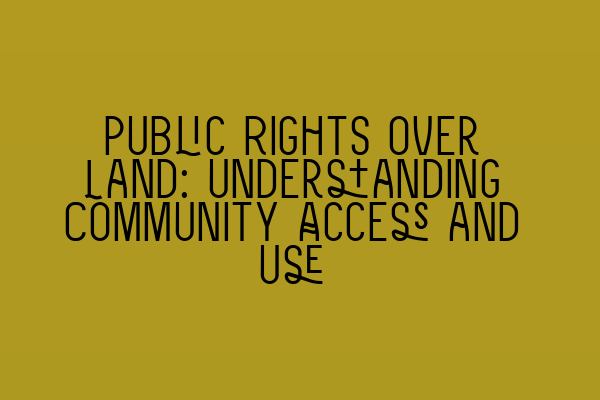Public Rights over Land: Understanding Community Access and Use
Public rights over land are a fascinating and complex area of property law. They involve the rights of individuals and communities to access and use certain areas of land for various purposes. Understanding these rights is essential for anyone involved in property law, as they can have a significant impact on land ownership, development, and planning.
In this blog post, we will explore the concept of public rights over land, including the types of rights that exist, how they are established, and the implications they have for landowners and the wider community. So, let’s dive in and unravel the intricacies of this interesting legal topic.
Types of Public Rights Over Land
Public rights over land can take several forms, each with its own set of conditions and limitations. Here are some of the most common types:
1. Right of way: A right of way is the most well-known public right over land. It typically grants individuals or communities the right to pass through a particular area of land, such as a footpath or road. These rights are often established by long usage or historic documents and can be crucial for public access, transportation, and recreational purposes.
2. Common land: Common land refers to areas of land that are owned collectively by a community or designated for public use. These areas may be used for activities such as grazing animals, collecting firewood, or even hosting community events. The rights associated with common land are often governed by local bylaws or customary practices.
3. Village greens: Village greens are areas of land in rural or urban areas that have been historically used by the local community for recreation and leisure purposes. These spaces provide important areas for social interaction and can be protected by legislation to ensure their preservation for future generations.
4. Foreshore rights: Foreshore rights pertain to the rights of the public to access and use the area of land between the mean high and low watermarks. These rights are often associated with coastal areas and can include activities such as fishing, swimming, and walking along the shoreline.
Establishing Public Rights Over Land
Public rights over land can be established in various ways, including:
1. Prescription: Prescription refers to the establishment of a right through long and uninterrupted use over a specified period. For example, a public footpath may become a right of way if it has been used by the public without interruption for a certain number of years. It is crucial to understand the statutory requirements and timeframes involved in prescription claims.
2. Statute: In some cases, public rights over land are established through specific legislation. For instance, the creation of a village green may be governed by legislation outlining the necessary steps to secure this status. Understanding the relevant statutes is vital when dealing with claims related to public rights over land.
3. Customary rights: Customary rights can be established through long-standing local traditions and practices. These rights may be recognized by the courts if they can be shown to have existed for a considerable period and have become part of the local customs.
Implications of Public Rights Over Land
Public rights over land can have significant implications for landowners and the community. Some key considerations include:
1. Development and planning: Public rights over land can restrict or influence development and planning decisions. For example, the existence of a public right of way may require developers to incorporate access points or maintain existing footpaths within their plans.
2. Land management and maintenance: Landowners with areas subject to public rights have certain responsibilities to ensure the appropriate upkeep and maintenance of those areas. Failure to comply with these obligations can lead to legal challenges and potential claims for compensation.
3. Dispute resolution: Disputes often arise between landowners and the public regarding the extent and validity of public rights over land. Understanding the legal avenues for dispute resolution is essential in finding fair and practical solutions for all parties involved.
In conclusion, understanding public rights over land is crucial in property law and land management. Whether you are a landowner seeking guidance on your obligations or a legal professional dealing with public rights claims, having a comprehensive understanding of this area of law is vital.
If you would like to explore further topics related to property law and land law, we invite you to check out our related articles:
– SQE 1 Practice Exam Questions: Prepare for your SQE 1 exam with our comprehensive practice questions and test your knowledge.
– SQE 1 Practice Mocks FLK1 FLK2: Enhance your SQE 1 preparation with our practice mocks that simulate the real exam conditions.
– SQE 2 Preparation Courses: Get ready for your SQE 2 exam with our tailored courses designed to cover all the relevant topics.
– SQE 1 Preparation Courses: Take advantage of our comprehensive courses to ensure you are well-prepared for your SQE 1 exam.
– SRA SQE Exam Dates: Stay up to date with the latest SQE exam dates to plan your study schedule effectively.
We hope that this blog post has helped shed light on the intricacies of public rights over land. Should you require any legal assistance or have further questions, do not hesitate to contact us at SQE Property Law & Land Law. Our team of solicitors is here to provide you with expert guidance and support.
